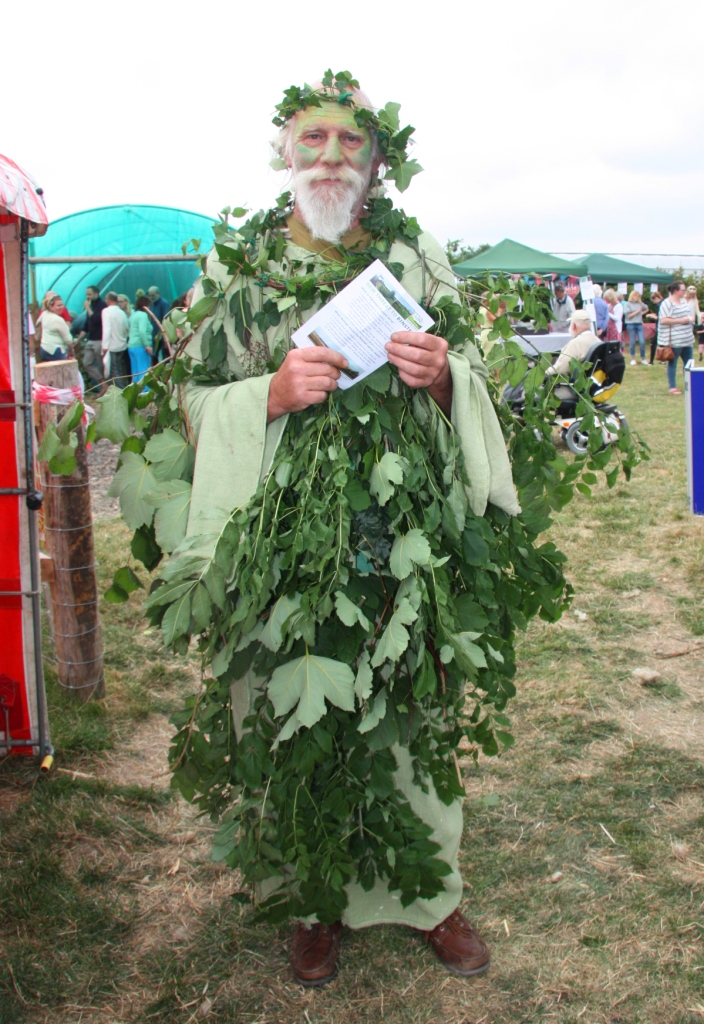Folklore
Binsted and Sussex Traditions
In the nature of Binsted's community and its sense of place and continuity; it is perhaps no accident that the founding Chairman and Treasurer of the charity 'Sussex Traditions' both live in Binsted. A flyer can be read here. If you love the connection to our Sussex past that Binsted offers: please visit the website www.sussextraditions.org and consider supporting the charity to help it conserve and share Sussex Traditions.
An ancient village landscape like Binsted naturally has its lore.
Here are some examples - more can be read in 'Binsted and Beyond'.
The Binsted Knucker Hole and Green Man
Binsted Farmer Luke Wishart writes that the ‘Knacker Hole’ in Burgess’s Field, south of Goose Green, ‘was a mythical hole, like the one at Lyminster which houses a dragon. Said to be the home of dragons, and bottomless’. His father Ernest Wishart had looked into this in the 1920s: there was talk of ‘water witches’. Luke however being of a scientific frame of mind, ‘arranged to place our irrigation pump into it to test the water capacity. The pump ran dry in just over 10 hours, and we could see the bottom. It filled up rapidly as soon as we stopped pumping. We didn’t find any dragons – but ... they may have escaped overnight.’
Another theory is that the knuckers hide, if the pond is drained, in the clay beneath the bottom. ‘Knucker’ comes from an old Saxon word nicor. It is typical of oral tradition continuing since Saxon times that the local versions of these ponds' old names, as popular awareness of their supernatural denizens faded, transmuted to more familiar similar words such as 'knacker'. In Saxon Germany they are more widely known as a kind of water sprite or ‘Nixe’; in Britain, they are only known in Sussex, the land of the South Saxons - indeed only in West Sussex. Possibly the knuckers were naturalised to England after arriving with the invading Saxons as early as the fourth century.
Theories about the origin of these small, round, bottomless, perpetually cold-water-brimming ponds are varied. Some say they were made by the knuckers themselves; others that the knuckers adopted pre-existing natural formations most probably created as sink holes. Certainly there is something dangerous not to say uncanny about them.
Here is storyteller Michael O'Leary's photo of the Binsted Knucker Hole pond:
The Binsted Knucker and its twin the Sompting Knucker (whose pond-hole area has the only other rare 'flushed fen' habitat in the West Sussex coastal plain) are celebrated on the Binsted Village Waymarker at the end of Church Lane, inaugurated February 2017:
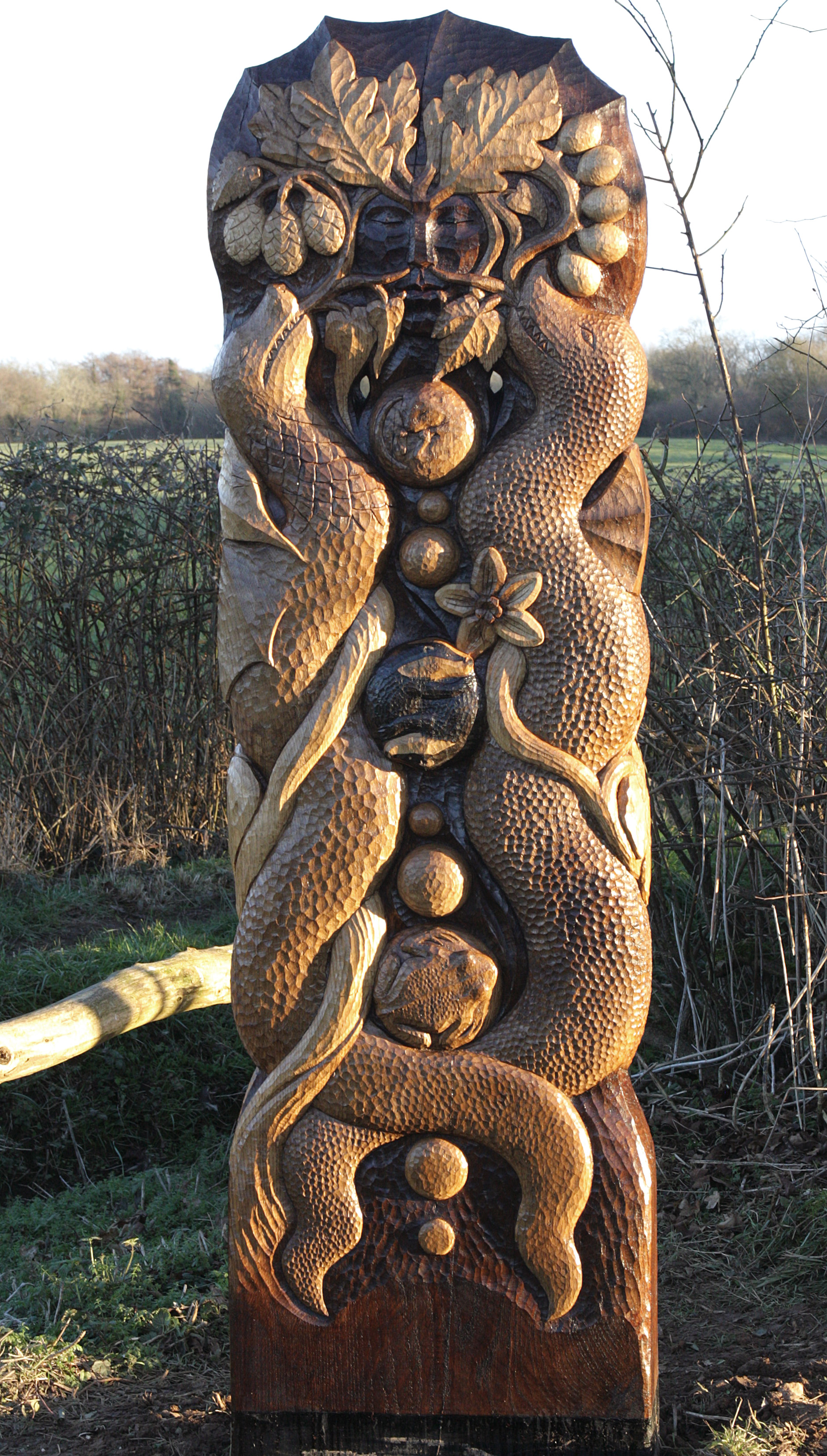
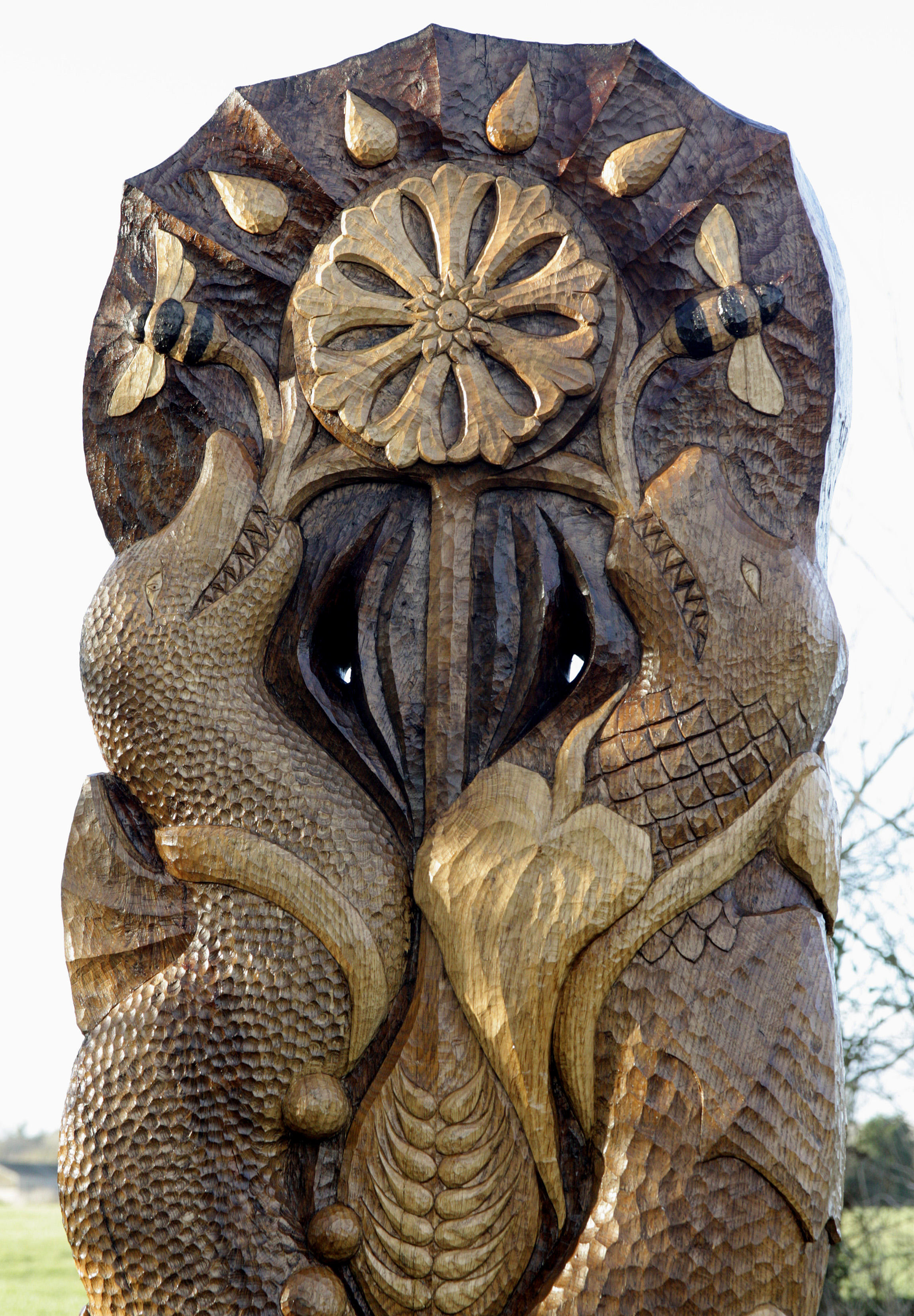
The Waymarker also features the Green Man, a Pan-like god-man-in-nature guardian figure found in old churches. In the mid 19th century, the Thatched Cottage had some sculptures similar in character built into its wall facing the track called Hoe Lane where this track comes up from the Knucker Hole into the village. At this time when the feeling for the unpredictable spirit of the Knucker would still have been strong, this placement of the sculptured horned-head and beard, which had been found in the 'Minchins Copse' woods at the other end of the Parish, may have felt like bringing the Green Man woodland guardian to the place where he was most needed. The Green Man appeared also at the 2016 Strawberry Fair. There, this manifestation of the Guardian of the village's woods and countryside handed out leaflets about the threat to our community and landscape from one of the options for an A27 Arundel Bypass.
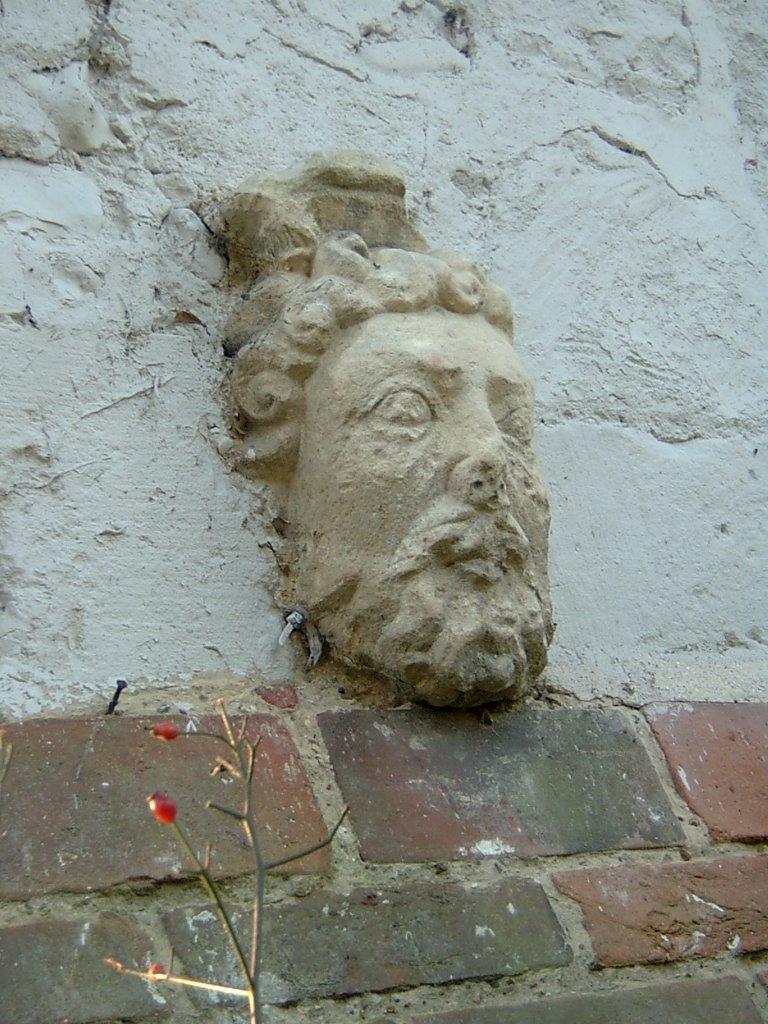
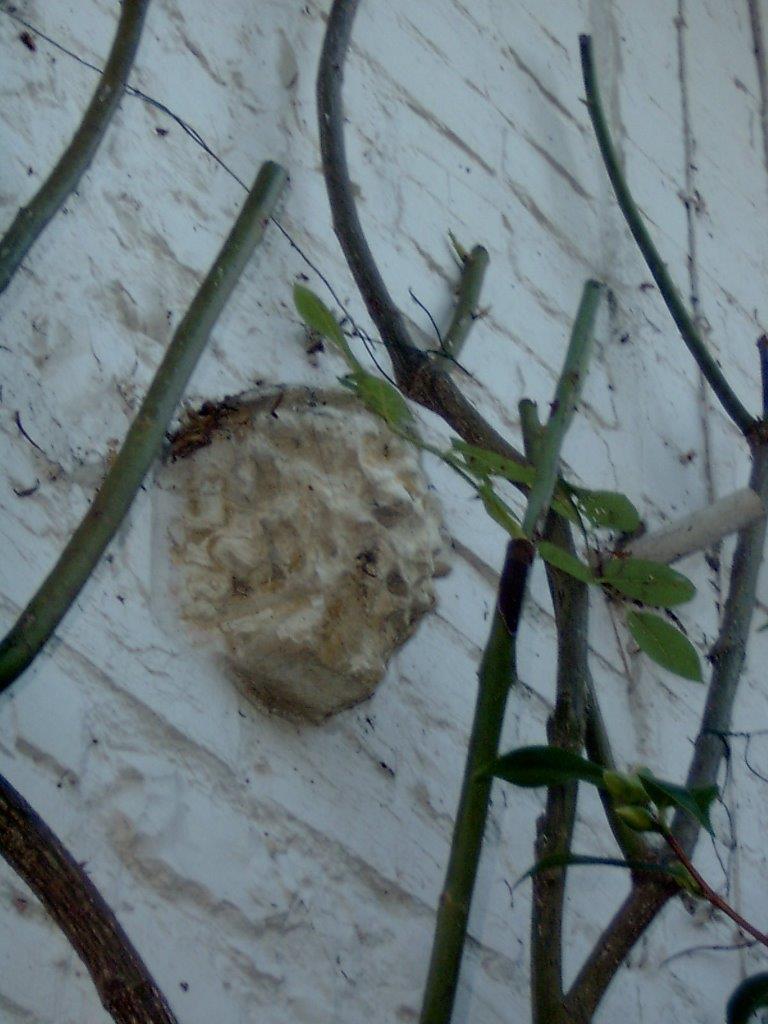
Other knucker holes are found along the coastal plain at:
- Lyminster - where the knucker dragon celebrated in numerous stories was slain by one Jim Puttock
- Sompting - where local lore in the 1940s told of the dangers and fears surrounding the sinister 'bottomless' pond where, two generations before, a cart and horses had been swallowed up and a farm worker pulled in and drowned. This knucker hole is overlooked by the railway line, and from a distance by the 10th-century Saxon cathedral of the downs, St Mary's Church Sompting, where Knights Templar readied themselves for service in the crusades - perhaps including a practice joust with the knucker dragon here?
- Worthing - near Ham Bridge
- Lancing - at Honeymans Hole, on the north side of Lancing Airport (now known as Shoreham Airport). How this hole got its name is unclear: one story is that honey was forces slang for night soil, and that the honeyman or night soil man from a camp tipped the night soil into the knucker hole, whereupon he was deservedly swallowed up, together with cart and horse.
Madonna Pond
It is an old Binsted myth that Binsted Pond (now known as the Madonna Pond) is bottomless. Sue Elphick remembers being told the pond was bottomless when she and Tony were buying Kent’s Cottage, nearby, in 1989. Not all Binsted myths are simply factual; but all are worth taking seriously.
John Heathcote, formerly Parish Clerk of Walberton Parish Council, took part in clearing work on the pond with West Sussex County Council in about 1994. He said: ‘I was expecting a flat or rounded hard bottom to the pond, because that is what I have found with other ponds I had dug out before (and since). We went happily in with a large digger. The depth of silt/sludge was much greater than anticipated, and we never got to the bottom of it, for fear of losing the machine, which was touch and go. If we had thought about it a bit more, it is logical that the pond is like the gully on the other side of the track, and that when the culvert and road were constructed, the resulting pond was V-shaped rather than U-shaped. I don’t think the depth is enormous, but equivalent to the gully on the south side, or similar.
Bill Pethers comments that in the 1980s police frogmen recovered a safe and other items from the pond and there was no mention of its being bottomless. The myth persists: there must be something at the bottom of it.
The Madonna statue
Other legends have grown up around this atmospheric grove with its dark pond, fallen trees, and shrine to Our Lady. Some of these, and other items of Binsted folklore, are summed up in an article in the Chichester Observer, 13 June 1980, headed ‘No Voodoo in Binsted Woods’:
Suggestions of black magic rituals bound up with legends of drowned children and haunted woods have been discounted. Speculation in the remote and straggling village of Binsted and nearby Walberton mounted with reports of a shrine to the Virgin Mary being destroyed and replaced by a cross and feathers - apparently a possible symbol of a voodoo brand of black magic.
But the rumours were described as ‘absolute rubbish’ by the woman who erected the shrine 34 years ago, Mrs Lorna Wishart of Marsh Farm, Binsted. She said the destruction of the shrine - featured in the Book of Shrines - was just vandalism. She replaced the damaged life-size figure - a monument to the Virgin Mary in memory of her dead mother - with a tiny replica of the Madonna surrounded by fluffy grasses and artificial flowers in front of a white-painted wooden cross. Encased in a wooden shelter covered with wire netting and stacked round with barbed wire, the new shrine stands on the old plinth - a tree-trunk painted silver, gold, green and blue with the words Maria Regina Salve Jesus. A fifth word is now indecipherable. It could be that the fluffy grasses decorating the present shrine have been mistaken for feathers and verbal reports of ‘a cross and feathers’ have been given a significance they do not deserve.
But legends of mystery and magic are not new to the eerie and isolated woodland glade where the figure stood overlooking the murky pool in which two children are said to have drowned many years ago. Local historians say the pool was built as an ornamental lake in the grounds of a manor house which was burnt down before World War II. Mr Dick Coen, of Arundel’s Tourist Information Office, said he understood several statues, some stone and some wooden, had been erected there in turn. As for the glade’s sinister associations he said: ‘It is no more than a persistent rumour. But a lot of people swear blind that when they pass it with their dogs, the dogs start crying and growling. Even those riding by on a horse have a job to get their horses to go on.’
This article contains many errors. Dates given imply the statue was put up in 1946; in fact it was 1952 or 3. The pond was originally one of three fishponds, rather than an ‘ornamental lake’. The house was not ‘burnt down before World War Two’; though it was no longer lived in, Margaret Pethers was still trying to keep it clean in 1943 or 4; still fairly intact, it was painted by Ralph Ellis in 1946, and much of its ruins remained until recently.
The original, life-size statue (brought back from Italy, where it had been blessed by the Pope) had no ‘shelter’. It was painted, with blue robes, but the paint began to peel and a wooden shelter or ‘howdah’ was put over it. This was smashed up and the statue painted red by vandals. Binsted resident John North recalled being asked by Mrs Wishart to make a shelter for the new, smaller statue out of a birdcage; he thought this impracticable. A new base was made by a Mr Bridges from Arundel. Mr Prosser put a Chubb moneybox in a tree – it was opened within 24 hours; Pat Davy put in another moneybox at some time, equally short-lived. The ‘painted plinth’ and barbed wire mentioned in the article are long gone. The shrine is now made solidly of brick, with an iron grille to protect the statue. The current brick surround is post-1987; the statue itself is a plaster replica.
In spite of the loss of some woodland to the south, in the vicinity of Binsted House (even though this has since been rebuilt in a new style), the grove retains its atmosphere. Stories will no doubt continue to be told.
The Beast of Binsted
Monstrous animals may be more common than knucker dragons around Sussex. They are usually black - the Black Dog, Black Rabbit, Black Horse giving their names to pubs - or black pumas or panthers. But not the Beast of Binsted - an enormous wild tabby-cat-like creature thought by some to be the survivor of a wildcat population that had held on amidst the tangle of Binsted's ancient countryside. It interbred with domestic and feral domestic cats around the village - cue ferocious screams heard on moonless Binsted nights, and the myth of the witch who screams thrice as she spins at midnight in Spinningwheel Copse. Many a Binsted household up until the 1990s had, by adoption, an intermediate but still by domestic standards huge tabby sired by the wild Beast of Binsted. Sadly the well-meaning households neutered these cats: but perhaps in a corner of Binsted the strain still lurks...
Binsted Ghosts
When Emma Tristram first put a note in the West Sussex Gazette asking for memories of Binsted, in 2000, Eric Phillips of Felpham sent her the following account.
Whilst driving on the track that runs NE towards Arundel Road, near Goose Green and Meadow Lodge, in about 1980, we were passing over the bridge when I observed a strange character smoking a clay pipe sitting on the low stone bridge wall (the containing walls are now gone because of heavy traffic coming from Arundel and Wishart’s farm). His clothes struck me as very strange and old, perhaps over a hundred years. As I passed I looked straight at him and I pulled the car up only 20 feet on to have another look, but lo and behold when I got out in approx. five seconds there was no-one there at all and there was nowhere this person could have gone in such a short time and it has been on my mind ever since.
I returned to the spot recently and found the low wall had gone and the area looked overgrown after the passage of twenty years. I spoke to a young lady who was passing through and lived nearby and I recounted my experience and she seemed rather concerned and mentioned that I could have talked to an older man about it but he had passed on. My wife who was with me in the first instance as we went over the bridge told me she saw nothing on her side of the car, but I saw what I saw and this account now I have put it on paper has in a small way given me some sort of relief.
Ernest Wishart used to say that the Madonna Pond was haunted by a coach and horses which had ridden into it and never come out. The ruins of Binsted House were said to be haunted by a man in a top hat. Bill Pethers remembers an incident from about 1943 or 4 when he was a small child:
‘Mother used to go up to the old house and try to keep the place clean. It was a time warp, you would walk through the door and you were back in the 1800s, and nothing had been touched. It was a labour of love, because the old place was falling down, that’s the reason why it was abandoned. There was a huge circular box hedge in the centre of the old front garden, not very high, with a gravel path, so you could drive in the main gate in your horse and carriage and drive round and back out again. One day, I think I was outside playing, and she suddenly rushed out and scooped me up and ran all the way down the road. There was something in there she had to get away from. It was a funny old house, very still, very quiet, and you could be there on a summer’s day and feel the hair on the back of your neck stand up. But I must admit I have never seen a ghost in my life.’
When asked who he thought Binsted House was haunted by, Bill Pethers replied ‘all my ancestors’! But he has his suspicions that the ghost Mr Phillips saw might have been the real form of his father, Henry Pethers.





